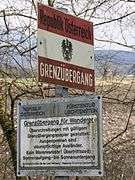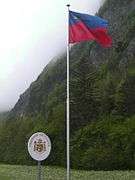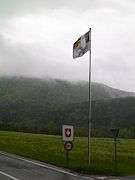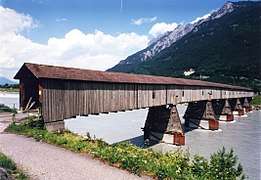Liechtenstein National Police Force
| Liechtenstein National Police Force Liechtenstein Landespolizei | |
|---|---|
 | |
| Common name | Landespolizei |
| Abbreviation | LL |
| Motto |
Für Gott, Fürst und Vaterland For God, Prince and Fatherland |
| Agency overview | |
| Formed | 1933 |
| Preceding agency |
|
| Employees | 125[1] |
| Annual budget | Secret |
| Jurisdictional structure | |
| National agency | Liechtenstein |
| Operations jurisdiction | Liechtenstein |
 | |
| Administrative divisions of Liechtenstein | |
| Size | 160 km² (61 sq mi) |
| Population | 36,000 |
| Governing body | Office of Civil Protection |
| Constituting instrument | |
| General nature | • Local civilian agency |
| Headquarters | Vaduz |
|
| |
| Sworn members | 125 |
| Unsworn members | 38 (Security Corps) |
| Elected officer responsible | |
| Agency executive |
|
| Divisions |
|
| Facilities | |
| Headquarters | Vaduz |
| Vehicles | 45 |
| Speedboats | 2 |
| Helicopters | 1[2] |
| Website | |
| http://www.landespolizei.li/ | |
Law enforcement in Liechtenstein is handled solely by the small Liechtenstein National Police Force (Landespolizei),[lower-alpha 1] composed of 91 officers and 34 civilian staff, a total of 125 employees (not including the Security Corps),[1] who police the 160 km² (61 sq mi) doubly landlocked alpine country in Western-Central Europe.[3] Bordered by Switzerland to its west, and Austria to its east,[4] Liechtenstein maintains a trilateral treaty which enables close cross-border cooperation between the police forces of the three countries; Liechtenstein is also a member of Interpol, and a signatory to a variety of other treaties.[5][6]
Crime
Liechtenstein has a significantly low crime rate, with the last murder taking place, according to a serving officer, “about ten years ago” as of 2007.[6] Crime has always been low since the mid-1970s when Liechtenstein started to prosper as a nation.[7] According to an International Special Reports study, the average Liechtenstein resident doesn't even lock their door.[8] Liechtenstein jails hold very few, if any, inmates, with sentences over two years being transferred to Austria.[6][8] However, officers in the Liechtenstein National Police Force have been armed since a shooting took place.[8] In 2004, Liechtenstein drafted 300 Swiss and Austrian police to assist security forces in the potential aftermath of a Liechtenstein victory over England, in a Euro Cup qualifying match, at Rheinpark Stadion.[9]
Structure
Liechtenstein National Police Force are divided into three divisions, and two independently operated subdivision:[10][11]
- Security and Traffic Control (64 officers; 5 civilian men and women); Administration Security and Traffic Unit, Security Unit, Traffic Unit, Traffic Engineering and Prevention Unit, Intervention Unit (police tactical unit),[lower-alpha 2] Border Unit, Riot Police,[lower-alpha 3] and Protection Unit.[lower-alpha 4]
- Criminal Investigation (16 officers; 10 civilian men and women); Administration Crime Investigation Division, Serious Crime Unit, Trace Unit, Financial Crime Unit, Forensic Unit, Crime Intelligence Unit. Officers are generally issued a SIG Sauer pistol the standard issue being the SIG Sauer P226.[12]
- Executive Support (7 officers; 15 civilian men and women); Chief of Staff,[lower-alpha 5] Systems Organization and Quality Department, Logistics, Emergence Command and Dispatch, Information Technology, State Penitentiary, and Relation Unit,
- Chief of Staff and Commissioner's Office (3 officers; 7 civilian men and women); Traffic and Administration Law Department, Legal Assistant, Commissioner's Office; Public Information Center, and Finance and Controlling.
- Security Corps (38 militiaman)[13][14][15] The Security Corps are a paramilitary force, composed entirely of Liechtensteiners, who can be called upon in case of a natural disaster, or riot situation. The Corps also performs honorary roles such as changing the guard, and presenting the Coat of Arms at official occasions. Differing from all other units (except for the Special Police Unit) the Corps are both trained and equipped with automatic weapons, most notably the Heckler & Koch UMP and MP5.
Security
Law enforcement in Liechtenstein is handled solely by the Liechtenstein National Police Force,[16] although a paramilitary force is maintained inside the police body.[13][14] Liechtenstein follows a policy of neutrality, and is one of few countries in the world that maintains no active military.[17] Liechtenstein's Army was abolished in 1868, soon after the Austro-Prussian War in which Liechtenstein fielded an army of 80 men, although they were not involved in any fighting.[7][16] However, Liechtenstein can reinstate its military if deemed necessary, although this is very unlikely.[18]
Swiss military
Switzerland has a relatively active military due to conscription. Several incidents have occurred during routine training:
- On 5 December 1985, antitank rocket RL-83 Blindicide fired by the Swiss Armed Forces landed in a forest in Switzerland owned by Balzers, a municipality of Liechtenstein, causing a forest fire. Compensation was paid to the private owner.[19]
- On 13 October 1992, following written orders, Swiss Army cadets unknowingly crossed the border and went to Triesenberg to set up an observation post. Swiss commanders had overlooked the fact that Triesenberg was not on Swiss territory. Switzerland apologized to Liechtenstein for the incident.[20]
- On 3 March 2007, a company of 171 Swiss soldiers mistakenly entered Liechtenstein by bad weather and by night, after taking a wrong turn in the darkness. The troops returned to Swiss territory before they had traveled more than 2 km into the country. The Liechtenstein authorities did not discover the "invaders", and were informed by the Swiss after the incident. The incident was disregarded by both sides. A Liechtenstein spokesman said "It's not like they invaded with attack helicopters".[21][22]
Policing treaties
Since 1933, Liechtenstein National Police Force has signed seven strategic treaties.[23]
- Working Group Southwest
- Europol
- International Police Association (IPA)
- Interpol
- Eastern Swiss police Concordat
- Police union boss Constance
- Organization for Security and Cooperation in Europe (OSCE)
Emergencies
The national emergency telephone number is 112, for police it is 117, for the Fire Brigade it is 118, for the Ambulance Service it is 144, and for the Rega it is 1414.[24] The Fire Brigade also operates a 30-man volunteer Mountain Rescue Service.[25] Officer uniforms are similar to that of the Swiss cantonal police, both in color, and design.[26]
Customs control
The Swiss border between Switzerland and Liechtenstein is opened, but Swiss customs officers used to secure Liechtenstein's border with Austria.[27][28][29] Before December 2011, there were 21 Swiss, 4 Liechtenstein National Police, and 28 Austria border guards, who secured the 11.6 km long Liechtensteiner-Austrian border, however, only 20 percent is passable.[30] Even though the Liechtenstein National Police Force maintain a border unit, the Swiss border police are responsible for border protection of both countries according to a customs union adopted in 1924.
In February 2007, there were hundreds of people trying to seek asylum in Liechtenstein, mainly from countries such as Somalia and Eritrea.[31] Due to the number of people attempting to cross the border, border guards were stationed on both the Liechtensteiner-Swiss border, and the Liechtensteiner-Austrian border, with the main objective of maintaining law and order for all Liechtensteiners.[32] This security measure lasted for about 90 days, with well over 800 people seeking asylum in Liechtenstein.[33][32]
In December 2011, Liechtenstein became the fourth non-European Union country to join the Schengen Area after Switzerland, Norway and Iceland.[34] Under the agreement, Liechtenstein will maintain an open border with both Switzerland and Austria, and will therefore, result in the closure of several Liechtensteiner-Austrian border stations.[35] In addition, Balzers Heliport will restrict all helicopters coming from non-Schengen countries, which in theory, should limit security concerns.[36] However, Liechtenstein will strengthen its customs control in the way of a high-tech video surveillance system (over 60 cameras costing $2.3 million), and regular mobile border patrol units.[32][35]
Border gallery
 Looking at an Austria border sign.
Looking at an Austria border sign.- Looking into Austria from Liechtenstein, with a joint border station.
- Looking into Austria from Liechtenstein, with a joint border station.
 Looking from Switzerland to Liechtenstein, with no border controls.
Looking from Switzerland to Liechtenstein, with no border controls. Looking from Liechtenstein to Switzerland, with no border controls.
Looking from Liechtenstein to Switzerland, with no border controls. Looking at a pedestrian bridge crossing the Liechtensteiner-Swiss border.
Looking at a pedestrian bridge crossing the Liechtensteiner-Swiss border.
Notes
- ↑ However, there are ten Interpol and two Europol agents stationed in Vaduz.
- ↑ The Intervention Unit, along with the Security Corps is considered by some Liechtensteiners to be a military unit, due in part to its deployment of body armour, a Bell UH-1 helicopter, and automatic weapons which include Heckler & Koch UMPs, Heckler and Koch MP5s, and SIG machine guns. The unit also has semi-military roles such as counter-terrorism, maritime security, air defense, prisoner transport, and assists the Protection Unit in escorting VIPs.
- ↑ Also called the Security Corps is one of two independently operated subdivisions.
- ↑ The Protection Unit is mainly used by the royal family, however elected officials, diplomats, or ordinary citizens may request protection from the unit. Since 1989 the Special Police Unit was assigned to assist in case of need.
- ↑ Also called the Chief of Staff and Commissioner's Office is one of two independently operated subdivisions.
External links
References
- 1 2 "Annual Report 2011 > Total force - 85 officers, 6 cadets, and 34 civilian staff" (PDF). Landespolizei. Retrieved 2012-06-18.
- ↑ Markus Herzig. "Swiss Helicopters - Current Fleetlist". Swissheli.com. Retrieved 2012-06-18.
- ↑ "Liechtenstein". OSCEpolis. Archived from the original on 1 April 2012. Retrieved 18 June 2012.
- ↑ "Geography".
- ↑ Landespolizei facts and figures Archived 16 May 2013 at the Wayback Machine.
- 1 2 3 "Comparative Criminology | Europe- Liechtenstein". Rohan.sdsu.edu. Retrieved 2012-06-18.
- 1 2 "CIA - The World Factbook". Cia.gov. Retrieved 2012-06-18.
- 1 2 3 "Police are rarely seen in this peaceful Principality". International Special Reports. Retrieved 2012-06-18.
- ↑ England. "Liechtenstein fear security will not be sufficient". Telegraph. Retrieved 2012-06-18.
- ↑ "Landespolizei Structure" (PDF). Archived from the original (PDF) on 16 May 2013.
- ↑ "About Us > Home". Landespolizei.li. Retrieved 2012-06-18.
- ↑ "Traffic instructions by a young Liechtenstein police woman". Flickr.
- 1 2 "Security Corps" (PDF).
- 1 2 "Annual Report 2011 > Total force - 85 officers, 6 cadets, 38 militiaman, and 34 civilian staff" (PDF). Landespolizei. Retrieved 2012-06-18.
- ↑ Liechtensteinische Landesverwaltung (23 March 2012). "Home - Amt für Bevölkerungsschutz". Llv.li. Archived from the original on 5 May 2012. Retrieved 18 June 2012.
- 1 2 "Top 10 Countries Without Military Forces | Top 10 Lists". TopTenz.net. Retrieved 2012-06-18.
- ↑ "Liechtenstein Military 2012, CIA World Factbook". Theodora.com. Retrieved 2012-06-18.
- ↑ christopher-eger.suite101.com
- ↑ VV, Arthur Brunhart /. "Balzers". HLS-DHS-DSS.CH.
- ↑ "Swiss Inform Liechtenstein of Error in Troop Maneuvers". New York Times. 1992-10-18. Retrieved 2009-11-27.
- ↑ "Swiss in Liechtenstein 'invasion'". BBC News. 2007-03-03. Retrieved 2007-03-03.
- ↑ (in French) Oups !
- ↑ "Police Associations". Landespolizei. Retrieved 2012-06-18.
- ↑ "Landespolizei Liechtenstein > Notrufnummern". Landespolizei.li. Retrieved 2012-06-18.
- ↑ "Bergrettung". Bergrettung.li. Retrieved 2012-06-18.
- ↑ "Landespolizei > Das sind wir > Polizeimuseum". Landespolizei.li. Retrieved 2012-06-18.
- ↑ "WTO - Trade policy review - Switzerland and Liechtenstein 2000". www.wto.org.
- ↑ "Relative Time". "Border bridge: Liechtenstein and Switzerland | Sophie's World Travel". Sophiesworld.net. Retrieved 2012-06-18.
- ↑ "Jan S. Krogh's Geosite: A-FL Boundary". Geosite.jankrogh.com. Retrieved 2012-06-18.
- ↑ "Schengen: Die letzten Tage der Grenzposten". Translate.google.com. Retrieved 2012-06-18.
- ↑ "Liechtenstein border control from CH. - English Forum Switzerland". Englishforum.ch. Retrieved 2012-06-18.
- 1 2 3
- ↑ "Landespolizei News > Official site". Landespolizei.li. Archived from the original on 2 July 2012. Retrieved 18 June 2012.
- ↑ "Liechtenstein Schengen membership lifts border controls with Switzerland.- swissinfo". Swissinfo.ch. Retrieved 2012-06-18.
- 1 2 "Border controls with Liechtenstein to cost Switzerland millions.- swissinfo". Swissinfo.ch. 2008-09-26. Retrieved 2012-06-18.
- ↑ "The Principality of Liechtenstein". Cyan.rrx.ca. Retrieved 2012-06-18.
